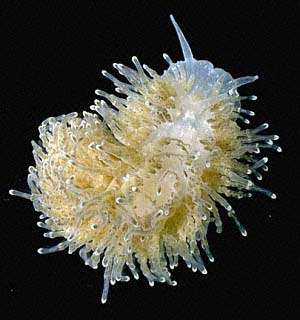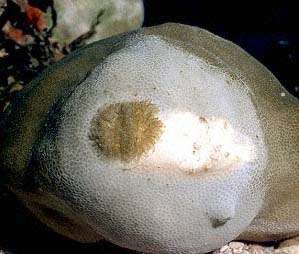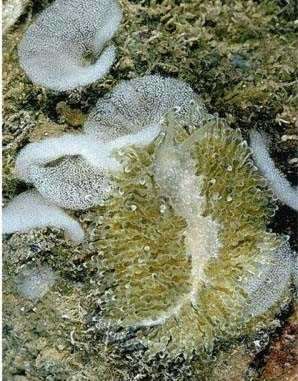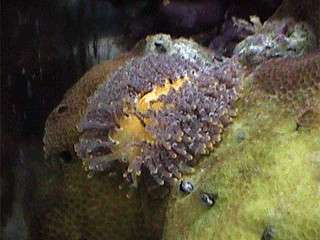
Phestilla lugubris
(Bergh, 1870)
Order: NUDIBRANCHIA
Suborder: AEOLIDINA
Family: Tergipedidae
DISTRIBUTION
Tropical Indo-West Pacific.
PHOTO
UPPER RIGHT: Koumac, New Caledonia, 30mm long, October 1993.
LOWER RIGHT: with egg ribbons, Koumac, New Caledonia, October 1993
LOWER LEFT: pair, 40mm long, on "home site" on Porites colony, Africana Bch, 1km S. Kunduchi Bch, Dar es Salaam, Tanzania, June 1978.
PHOTOS: Bill Rudman.
RELATED TOPIC
Widespread throughout the tropical Indo-West Pacific, P.lugubris feeds on colonies of the coral Porites, often in very shallow waters. Probably much more common than realised, it is very cryptically coloured and often hidden in crevices and beneath the coral blocks to avoid heavy fish predation.
Animals are often remain in pairs for many weeks and occupy a "home site". In the photo below are a pair on a colony of Porites. Note the intense white "homing scar" where the coral skeleton is completely obliterated, and the wide dull white area around the Phestilla where the coral polyps have been eaten. Each animal lays up to about 25 large egg ribbons. Veligers hatch after 7-9 days. The veligers are lecithotrophic (non-feeding) and spend between 7-21 days in the plankton.
If you look carefully at the cerata of species of Phestilla you will see that the tip is white and swollen. Microscopically, the normal cubical epithelial cells have been replaced by long, columnar glandular cells which exude a sticky, apparently defensive secretion. The typical aeolid cnidosac is absent, because the nematocysts in their coral food provide little protection from predators. In a remarkable convergence with the unrelated soft-coral feeding Phyllodesmium, species of Phestilla also produce sticky ceratal secretions and are able to autotomise (break off) their cerata when disturbed or roughly handled.
Reference:
• Rudman, W.B. (1981a) Further studies on the anatomy and ecology of opisthobranch molluscs feeding on the scleractinian coral Porites. Zoological Journal of the Linnean Society, 71: 373-412.


Rudman, W.B., 1999 (May 17) Phestilla lugubris (Bergh, 1870). [In] Sea Slug Forum. Australian Museum, Sydney. Available from http://www.seaslugforum.net/find/pheslugu
Related messages
Coral-feeding Phestilla lugubris from East Timor
December 18, 2008
From: Brian Francisco


Hi Bill
I've been meaning to send you these two photos for quite a while. I've hesitated because I'm not really sure if they are sea slugs, some other animal, or a figment of my imagination. What caught my eye was the resemblanse to the serata of a solar-powered Phyllodesmium.
My apologies for limited angles on the photos, but the animals (two?) were in a coral crevice. Although I can not discern any telltale features, I hope your expert eye can provide some help.
Locality: Dili Rock, 12 meters, East Timor, Banda Sea, 9 March 2008, coral reef. Length: 2cm. Photographer: Brian Francisco.
Thanks very much
Brian
francisco.brian@gmail.com
Francisco, B., 2008 (Dec 18) Coral-feeding Phestilla lugubris from East Timor. [Message in] Sea Slug Forum. Australian Museum, Sydney. Available from http://www.seaslugforum.net/find/22105
Dear Brian,
These are the coral-feeding aeolid, Phestilla lugubris. This species feeds on species of Porites coral. Interestingly animals often pair up and form a 'home' spot on the underside of the coral colony they are feeding on, or in a dark crevice, as you describe. Small animals are very difficult to see because the colour of the digestive gland in the cerata is identical to the colour of the region of the coral they are feeding on. Have a look at the coral-feeding Fact Sheet for links to more information on this specialised life style. When I first studied them I wondered if they were solar-powered, like species of Phyllodesmium, but they do not retain the zooxanthellae in their tissues and have no anatomical adaptations to assist in 'farming' zooxanthellae.
The white 'caps' you can see covering the tips of the cerata are interesting because they cover a swollen layer of special sticky glands found in species of Phestilla [see coral-feeding defense]. As its coral food has feeble nematocyts, Phestilla replaces the cnidosac with this thick layer of gland cells.
Best wishes,
Bill Rudman
Aloha from Hawaii
April 24, 2003
From: Rita Bishop


Aloha bill!!
What a wonderful wealth of information!! thanks for all you do!!
I have a friend who sent me a pic of a nudi .. it was taken at a location at Kahe Beach, Hawaii .. the depth was 20ft and it was on a large outlet pipe for an underwater cooling syetem for the electric company accross the beach. There are usually TONS of blue dragon nudis on the pipe but this one was the shape of a spanish dancer with the color of a blue dragon?? Anyway I will attach photo .. it also shows a wonderful leaf scorpion fish :-) .. any help would be appreciated. thanks!!
Aloha,
Rita Bishop
usdiver97@aol.com
Dear Rita,
Perhaps I shouldn't say so but I have a soft spot for fish like Antennarius and its relatives. I was watching one one day wondering how it could keep so still, and then saw how the exhalent opening to the gill pocket had moved to the 'elbow' of its stocky front 'legs'. In this way it could circulate water through its gills without the telltale cheek movements normal fish have to make.
Now before I completely upstage your equally interesting nudibranch. The clue to its identity is the large Porites coral colony behind the fish, and on which the nudibranch is sitting. It is the coral-feeding aeolid Phestilla lugubris. Have a look at the other messages on this page for more information on its biology, and go to the coral-feeding page for more general information on coral feeders.
Best wishes,
Bill Rudman
Phestilla lugubris from Christmas Island
May 4, 2002
From: W.B. Rudman

Here is a reord of Phestilla lugubris from John Hicks' Christmas Island collections.
PHOTOS: AM C130156, 13 June 1981, off District Officer's Point, on wreck under rock. 30 mm long alive. Found with 17 mm egg disk., Christmas Is., Indian Ocean. Photo: John Hicks
Best wishes,
Bill Rudman
Re: The coral-eating Phestilla lugubris
March 8, 2000
From: Kiichi Masu Chiba


Dear Bill,
Thanks for your prompt reply.
I herewith attach another two photos - pictures of his front view. You can find two pairs of tentacles on his face. I believe that he is Phestilla lugubris as you identified. It is just like the pics which you showed me.
Especially, they have got exactly same tentacles and the shape of bodies is almost same. He is beautiful and attractive. Is he an unusual kind?
I moved him to the soft coral tank with the Christmas tree worms rock. Because, this tank has another SPS. At that time, I carefully observed the worm rock to find another Phestilla lugubris. But, I could not find any of his friends even a small juvenile.
However, I have to choose him or the coral to die as you wrote. This is a very painful decision for me. I live in Central London, faraway from the real reef. I have no chance to return him to real reef safely. Moreover, It's so painful to see the coral turning into a skeleton even if the worms are happy.
..... However, I will keep Zira (This is Phestilla lugubris's Name, I named) in Soft Coral tank. I think, This is a providence of nature or obligation of reef keepers though it is sad that the coral will be eaten up.
How do you think of my decision as a biologist?
Kiichi Masu Chiba
kiichin@dircon.co.uk
Chiba, K.M., 2000 (Mar 8) Re: The coral-eating Phestilla lugubris. [Message in] Sea Slug Forum. Australian Museum, Sydney. Available from http://www.seaslugforum.net/find/2062Dear Kiichi,
From your new photos it is definitely Phestilla lugubris. I think I can see where part of the coral has been eaten. If you look on the right of the photo, the coral looks green. That is a thin layer of algae growing over a dead part of the coral skeleton. What do I think of your decision? I am biased in favour of the nudibranch so I think you made the right decision.
Is he unusual? They are probably quite common in the tropical Indo-West Pacific but seem to be subject to heavy predation by fish. In fact they do much better in aquaria, without fish bothering them, and grow to a much larger size than you normally find them in the wild.
Glad to have solved your puzzle,
Best wishes,
Bill Rudman.
My new companion (Phestilla)
March 6, 2000
From: Kiichi Masu Chiba


Dear Bill,
I have found a new companion in my small reef tank. It looks like a soft coral. However, it has pair of two tentacles, and moves slowly.
I guess that this is a family of sea slug.
I send you two pictures, pictures quality might be bad and I cannot still take the front view. The upper photo is back view of it when slowly moving, you can see pair of tentacles on his head, there is another pair of tentacles at his mouth. The lowr photo is totally back view.
The body length is one inch. And almost flat circle shape. This animal has bright yellow body, and has an innumerable tentacle (looks like soft corals) in the place where the central line of the back is excluded. The thing like the tentacle is purple color and bright yellow spot on tip.
He always be on the Christmas tree worm rock, He never come away from there. But he does not seem to be eating the worms or corals. I worry what he eats and I worry about the influence that he exerts on my tank too. If you have knowledge of it, Please kindly help me.
Very thanks,
Kiichi Masu Chiba
kiichin@dircon.co.uk
Chiba, K.M., 2000 (Mar 6) My new companion (Phestilla). [Message in] Sea Slug Forum. Australian Museum, Sydney. Available from http://www.seaslugforum.net/find/2037Dear Kiichi,
Your new companion is a species of the coral-eating aeolid genus Phestilla. Although it seems to be a little more heaviy pigmented than usual I think it is Phestilla lugubris which feeds exclusively on some species of the coral Porites. The 'rock' your Christmas tree worms are in is a living colony of Porites.
Another possibility is Phestilla sp. 1, which can have yellow-tipped cerata, but it in feeds on another coral. I suspect your animal was a very small juvenile when you got your coral colony and has been feeding and growing in your aquarium. Have a look for white patches on the Porites colony - they may be underneath or on the sides of the colony. If you find any it will be a sure sign that the slug is feeding on it. You will then have to decide whether you want the slug or the coral to die. I think the worms will continue to live quite happily in the coral skeleton even if the coral animal is dead.
The 'tentacles' you describe are special organs found in aeolid sea slugs. Have a look at the Cerata Page to find out about them.
Best wishes,
Bill Rudman.
The coral-eating Phestilla lugubris
May 17, 1999
From: Bill Rudman
I have added a page on the coral-eating aeolid Phestilla lugubris. It is the first of a number of pages I will be adding on corallivorous nudibranchs.
Bill Rudman.
